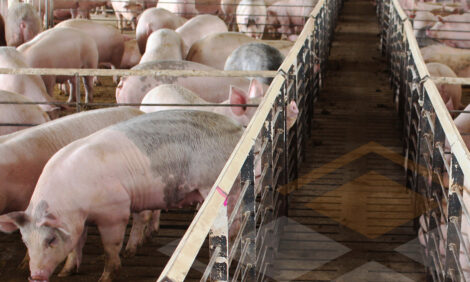



Making the most of global opportunities
By Anne Birgitte Lundholt, Managing Director, Danish Bacon & Meat Council (Danske Slagterier) Copenhagen - The Danish pork and bacon industry is ready to make the most of new opportunities in the global market. Falling prices through 2002 and temporary upheavals in the global marketplace have not dashed the optimism and drive in the Danish pork and bacon industry. Despite difficult conditions and tougher competition, the pig farmers as well as the food industry have maintained their competitive edge and managed to keep ahead of their international rivals. Looking forward to 2003 and beyond prospects are fairly good.
Despite difficult conditions and tougher competition, the pig farmers as well as the food industry have maintained their competitive edge and managed to keep ahead of their international rivals. Looking forward to 2003 and beyond prospects are fairly good.
New markets
By May 2004 eight Central and East European countries as well as Cyprus and Malta will become members of the European Union. We are proud of the fact that the agreement on enlargement was reached during the Danish EU-presidency and finalized at the Copenhagen summit in December 2002.
This is truly a remarkable achievement. As the Danish Prime Minister, Mr Anders Fogh Rasmussen, stated at the summit: “Europe is spreading its wings – in freedom, in prosperity and in peace.”
Enlargement will provide new business opportunities for the Danish food industry. We are confident that the quality of our pork and bacon products will be in demand in many of the new member countries, and we are ready to face the competition from the Central and East European pig farmers and food industry.
In the short term the new member countries will import more pig meat and pork products, estimated to be in the region of 800.000 to 1.200.000 tonnes by 2007. The Danish food industry intends to make the best of this opportunity to expand in the European market which will benefit from increasing trade and prosperity in the years to come.
Export performance
Given the small size of the country, it is extraordinary that Denmark has so far maintained its position as the world´s largest exporter of pork.
In 2002 total production amounted to 1,9 million tonnes, and 1,6 million tonnes were exported to more than 130 countries across the world.
Inside Europe Germany (325.000 tonnes) and Great Britain (300.000 tonnes) are our most important markets. Italy has emerged as an attractive market, imports from Denmark amounting to 140.000 tonnes.
Overseas, Japan is once again the frontrunner with imports of Danish pork reaching a record level of 240.000 tonnes last year.
Despite low pig prices and fierce competition Danish pork thus remain very competitive on the world market.
Producer income has been unsatisfactory throughout most of 2002, at times reaching levels below the cost of production. Prices are not expected to improve significantly until next autumn, but looking beyond that the pig farmers as well as the food industry are preparing for increased demand and much better prices.
In the present situation farmers have found a renewed emphasis on efficiency and improved management. Investment has remained at a high level throughout the business. Farmers are investing heavily in confinement-free systems, to mention but one important area. Next year, Danish Crown will complete a new slaughterhouse, technologically the most advanced in the world. It is the biggest investment ever in the company. TiCan, the other mayor player in the business, has invested in new slaughterhouse- and processing facilities.
Animal welfare
Animal welfare remain an important issue in the Danish pig industry. Farmers have to get to grips with new pieces of legislation as well as consumer demands, especially in Scandinavia and northern Europe.
Many of the new provisions go beyond EU legislation, challenging Danish farmers to turn a competitive disadvantage into a product advantage in the market place. The number of sows living in confinement-free systems will exceed 50 percent this year and 70-80 percent within the next five years, bringing the farmers well ahead of legislative deadlines. The new EU-provisions to provide rooting material and cool showers facilities for the pigs are already being implemented by many farmers.
Transport is another issue on the political agenda in Denmark and the EU. More than 90 percent of Danish finishers spend less than two hours on the road to the slaughterhouse. With much lower mortality during transport than any other major pig producing countries, we sometimes find it difficult to understand the importance attached to this issue by Danish politicians. Nevertheless, we agree that that animal transport must be strictly regulated and controlled to satisfy public opinion. We are committed to further improvement in this area, being aware, of course, that costs do not hamper our competitive edge. As it is, Danish pig producers bear costs not experienced by many of their competitors in the EU and elsewhere.
The environment
A responsible approach to the environment is vital to maintain the corporate reputation of any business today. The Danish pig producers have achieved significant results in the application of nitrogen, reducing the release by more than 40 per cent over the last 15 years in spite of increased production. This is very important as the environmental lobby in this country remains strong.
The Danish producers have to comply with tougher nitrogen application than other EU-countries – 140 kg per hectare as opposed to the EU-requirement of 170 kg per hectare.
We are currently engaged in constructive dialogue with the Danish government about new legislation which we hope will eventually help in the development of new technologies to further reduce the environmental impact of modern farming and allow a more flexible application of current regulations which prevent our producers from achieving financial benefits on a scale available to our competitors.
Slaughterhouses and meat processors continually work to improve their environmental performance by the adoption of “clean” technologies.
Food safety
Food safety standards in Denmark have been enhanced in recent years. Antobiotic growth promoters (AGP) were removed from production by January 1, 2000, on the initiative of the pig producers. This is indeed a significant change in production systems and has been widely applauded by the consumers.
We have lead the field in this area amid controversy on further restrictions on the use of AGP´s
in the EU and elsewhere. Some have tried to present a distorted picture of the Danish experience. Nevertheless we remain committed to our strategy and we are confident in the long-term success of our approach which was vindicated by EU-decisions last year to ban a number of AGP´s. Though some of our producers have suffered losses in the wake of withdrawal of AGP´s from weaners and finishers, this is by no means the general picture. Most producers have been able to solve problems through improved management, and the use of therapeutic medicine has been kept at a low level.
The overall use of antibiotics has nearly halved since 1995. Our new comprehensive VETSTAT database shows that antibiotic use has now fallen to 3g per pig produced. We believe that compares favourably to most other countries in the world.
The Danish programme to control Salmonella at all stages of the production has been in place for a decade. To our delight, it is being “copied” by a number of countries. In Denmark, we have seen a sharp decline in the number of cases of Salmonellosis in the human population, with very few cases attributed to pig meat.
Infrastructure
Recent analysis has shown that in the key areas of production efficiency, such as the pigs produced per sow and feed conversion, our producers compare favourably to many of our competitors. The best farmers now produce close to 30 pigs per sow.
If Denmark is to continue to carry additional costs in delivering improved results on animal welfare, food safety and environment, it is crucial that producers and the food industry are equipped with the best know-how and management skills to face the emerging challenge from the world´s lowest cost producers in countries as Brazil and Canada – and in the longer term the new EU member countries.
In this field, the Danish Bacon & Meat Council, the National Committee for Pig Breeding, Health and Production and the Danish Meat Research Institute – all part of the same organization – are important performance drivers. The strength of our industry is a well integrated infrastructure based on the co-operative system. The pig farmers own the slaughterhouses and the meat processing companies. This unique structure provides an opportunity for a fully integrated chain from farm to table and guarantees traceability between the companies and their producer members.
It remains vitally important for us to be able to operate factories at near full capacity and adapt to ever changing demands from the retail trade and consumers.
Market access and high standards
The Danish Bacon & Meat Council hope that the Doha Round in the WTO-negotiations will provide increased access in the global market and commit countries across the world to high standards of food safety, hopefully bringing about fair trading conditions and thus fewer upheavals in the market.
Though we realize that competition will be fierce in the years to come, we remain confident that we can keep up our overall performance and still progress further in the fields of breeding, feeding, housing systems, animal welfare, the environment and new products to suit consumers worldwide.
Developing new products is vital to the Danish pork and bacon industry. So far we have succeeded in maintaining a good track record of moving ahead of consumer requirements, but as our competitors improve their performance this is the key to future success for our industry.
Source: Danish Bacon & Meat Council (Danske Slagterier) - 28th May 2003






